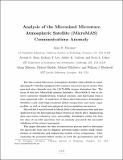Analysis of the Microsized Microwave Atmospheric Satellite (MicroMAS) Communications Anomaly
Author(s)
Marinan, Anne D.; Hein, Ayesha Georgina (Ayesha Georgina Iwalanai); Lee, Zachary T.; Carlton, Ashley K.; Cahoy, Kerri; Milstein, Adam B.; Shields, Michael W.; DiLiberto, Michael T.; Blackwell, William J; ... Show more Show less
DownloadMarinan_et_al_MicroMASAnomalyPaper.pdf (2.998Mb)
Terms of use
Metadata
Show full item recordAbstract
The Micro-sized Microwave Atmospheric Satellite (MicroMAS) is a dual- spinning 3U CubeSat equipped with a passive microwave spectrometer that operated nine channels near the 118.75-GHz oxygen absorption line. The focus of this first MicroMAS mission (hereafter, MicroMAS-1) was to ob- serve convective thunderstorms, tropical cyclones, and hurricanes from a near-equatorial orbit. A small fleet of Micro-sized Microwave Atmospheric Satellites could yield high-resolution global temperature and water vapor profiles, as well as cloud microphysical and precipitation parameters. MicroMAS-1 was delivered in March 2014 to the launch provider and was deployed from the International Space Station in March 2015. Engineering data and sensor telemetry were successfully downlinked within the first few days of on-orbit operation, but an anomaly prevented the successful validation of the science instrument. This paper discusses the data reconstruction process used to determine the spacecraft state and to diagnose potential failure modes using combi- nations of simulations and engineering models of key components. After analyzing the potential failure modes on both the groundstation and the spacecraft, results indicate that one of the solar panels may have not prop- erly deployed, leading to the most likely cause of failure: damage to the on- board radio transmitter power amplifier. A re-flight mission, MicroMAS-2, has two launches (2a and 2b) planned for 2018.
Date issued
2018Department
Massachusetts Institute of Technology. Department of Aeronautics and Astronautics; Lincoln LaboratoryJournal
Journal of Small Satellites
Publisher
A. Deepak Publishing
Citation
Marinan, Anne D. et al. "Analysis of the Microsized Microwave Atmospheric Satellite (MicroMAS) Communications Anomaly." Journal of Small Satellites 7, 1 (2018): 683-699 © A. Deepak Publishing
Version: Author's final manuscript